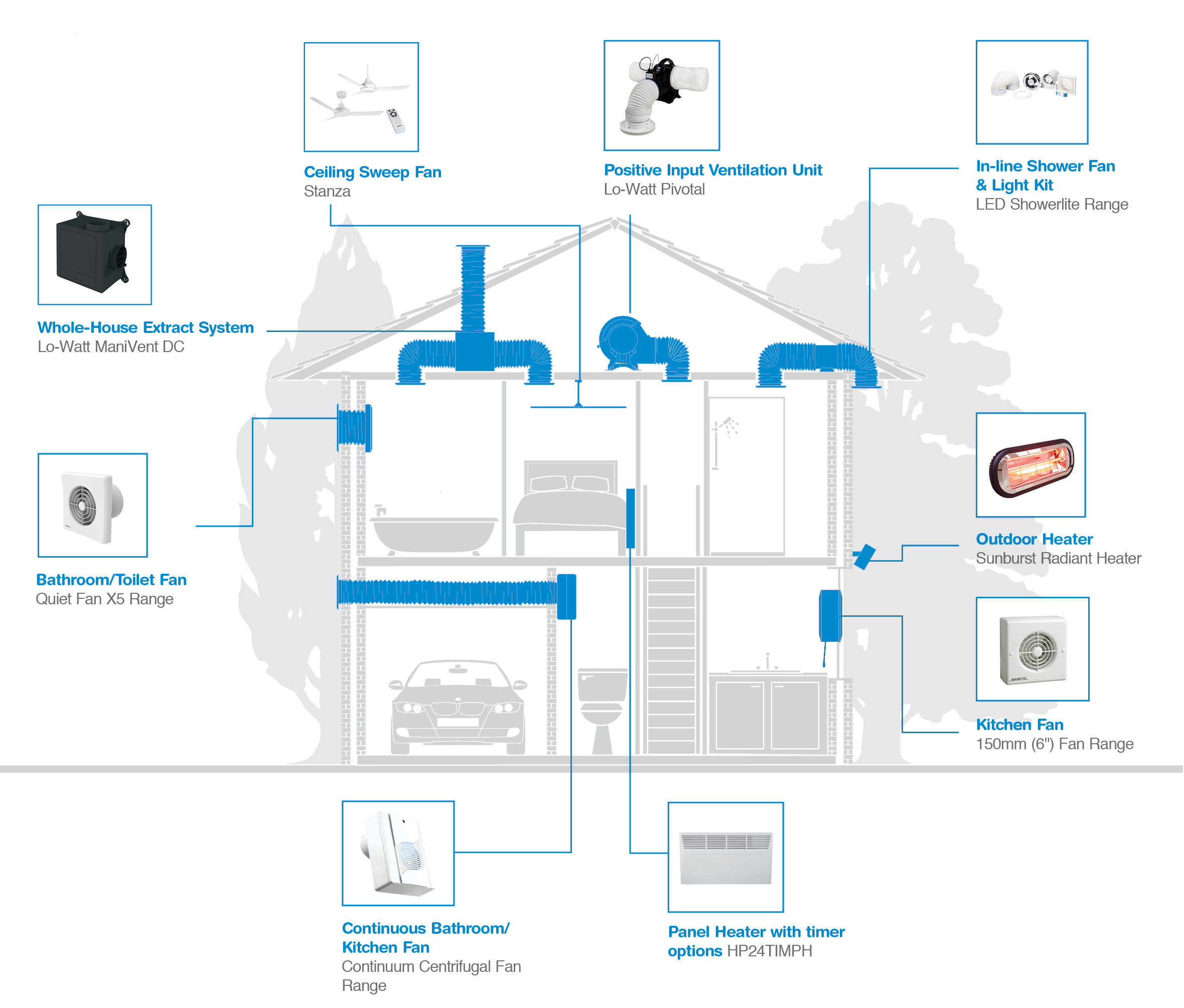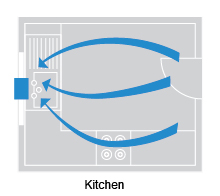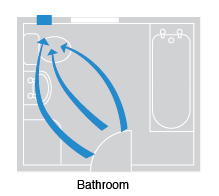How to Choose a Ventilation Fan

The Problems caused by Poor Ventilation
Stale Air
Stale air can be caused by cooking smells, smoking, odours remaining in the bathroom, a general lack of ventilation around the house as well as a damp atmosphere.
All these problems cause an avoidable level of discomfort as well as the risk of respiratory illness and general poor health.
Condensation
Problems occur when steam from the kitchen or bathroom finds cooler surfaces around the house on which to condense. Attempts to conserve heat by sealing windows – and therefore reducing natural ventilation – makes this problem even worse.
Condensation can cause considerable problems from peeling wallpaper and mould growth to severe structural damage such as wood rot and damp.
Solving the Problems
Building Regulations
The Building Regulations Document F1 (2006 Edition) outlines the importance of ventilation and stipulates that mechanical ventilation must be installed in kitchens, bath/shower rooms and toilets. All Manrose fans comply with or exceed current Building Regulations and are capable of extracting the rates required by Building Regulations. This means that humidity is removed at source before it can reach the cooler part of the dwelling and cause damage. Specific requirements of The Building Regulations Document F1 (2006 Edition) on ventilation are as follows:
Intermittent Fans
Intermittent fans operate on an ‘as required’ basis and turns on and off with the light switch or via other controls. They provide peaks of high extraction for a short period of time.
Bathrooms/Shower Rooms:
The Regulations require a fan capable of minimum extract capacity of 15 litres per second when installed.
Toilets (Separate from a Bathroom):
The Regulations require a fan capable of a minimum extract capacity of 6 litres per second when installed. N.B. If a room does not contain an openable window the fan should be fitted with a 15 minute over-run timer.
Kitchens:
The Regulations require a fan capable of extracting 60 litres per second when installed.
Utility Rooms:
The Regulations require a fan capable of extracting 30 litres per second per second when installed.
Continuous Fans:
Continuous Running Extractor Fans work by extracting excess moisture and stale air at a low rate throughout the day with a boost function for when humidity levels rise. This method ensures better indoor air quality and uses less energy than intermittent fans, therefore the fan is more cost effective to run.
Bathrooms/Shower Rooms:
The Regulations require a fan capable of minimum extract capacity of 8 litres per second when installed.
Toilets (Separate from a Bathroom):
The Regulations require a fan capable of a minimum extract capacity of 6 litres per second when installed. N.B. If a room does not contain an openable window the fan should be fitted with a 15 minute over-run timer.
Kitchens:
The Regulations require a fan capable of extracting 13 litres per second when installed.
Utility Rooms:
The Regulations require a fan capable of extracting 8 litres per second per second when installed.
Siting the Fan Correctly
 A fan should always be sited in the furthest window or wall from the main source of air replacement to avoid short-circuiting the airflow. It should be located as high as possible in the window or wall nearest to smells or steam, but not directly above eye-level grills or cooker hoods.
A fan should always be sited in the furthest window or wall from the main source of air replacement to avoid short-circuiting the airflow. It should be located as high as possible in the window or wall nearest to smells or steam, but not directly above eye-level grills or cooker hoods.
If the room contains a fuel burning device (such as a gas boiler) with a non-balanced flue, it is essential that there is enough replacement air to prevent fumes being drawn down the flue when the fan is extracting to its utmost capacity.
IEE Regulations (U.K.) require that a conventional mains voltage fan in a bathroom or shower must be located where it cannot be touched by a person using the bath or shower and well away from any water spray.
 Alternatively, the new Manrose range of 12 volt S.E.L.V. (Safety Extra Low Voltage) fans are specifically designed for the safe ventilation of toilets, bathrooms and shower rooms and can be fitted within the splash area with absolutely no risk of electric shock.
Alternatively, the new Manrose range of 12 volt S.E.L.V. (Safety Extra Low Voltage) fans are specifically designed for the safe ventilation of toilets, bathrooms and shower rooms and can be fitted within the splash area with absolutely no risk of electric shock.
Minimum Air Changes Required Per Hour
To calculate the correct fan required for a particular room you need to know the room volume in cubic metres, i.e. length x breadth x height, and then multiply by the number of air changes required.
|
Bathroom & Shower Rooms
|
3
|
Conference Rooms
|
8
|
Living & Other Domestic Rooms
|
3
|
Sports Facilities
|
6
|
|
Bedrooms
|
2
|
Garages
|
6
|
Meeting Rooms
|
4
|
Store Room
|
3
|
|
Cafés
|
10
|
Hairdressing Salons
|
10
|
Offices
|
6
|
Toilets – Domestic
|
3
|
|
Canteens
|
8
|
Halls & Landings
|
3
|
Restaurants & Bars
|
6
|
Toilets – Public
|
10
|
|
Cellars
|
3
|
Hospital Rooms
|
4
|
School Rooms
|
2
|
Utility Rooms
|
15
|
|
Changing Rooms with Showers
|
15
|
Laundries & Launderettes
|
10
|
Shops
|
8
|
Workshops
|
6
|
| Example 1 | Example 2 | |
| Room | Bathroom | Kitchen |
| Volume | 2.0 x 2.0 x 2.0 = 8m³ | 2.8 x 2.8 x 2.8 approx = 22m³ |
| Number of Air Changes Required | 3 | 10 |
| Performance | 8 x 3 = 24m³/h | 22 x 10 = 220m³/h |
| Fan Required | XF100T = 85m³/h | WF150A = 220m³/h |
Stale air is also removed by installing the appropriate Manrose fan. In certain circumstances, such as in toilets, a timer is incorporated to provide an automatic turn-off period of 15 minutes as stipulated in The Building Regulations.
Choosing the Right Manrose Fan
Remember:
- Axial Fans: are designed to move air over short distances i.e. window fixing or through mounting and are not suitable for ducting over 2 metres in length. Available in 4″, 5″, 6″, 9″ and 12″ sizes.
- Centrifugal Fans are designed to move air over longer distances and will perform well against the pressure caused by long lengths of ducting and resistance by grilles. N.B. When ducting vertically it is recommended that a condensation trap is used.
- Humidistat Controls: Manrose have a complete range of integral Humidistat Controls on all their fans, they are also available with a pullcord the bathroom and off as it falls. It will continue to monitor the humidity 24 hours per day, thus preventing mould growth on walls and ceilings and drastically reduces condensation problems.
Types of Model
- Standard. For remote switching through wall light or separate switch
- Timer model with built-in adjustable time delay operated by the light switch.
- Pullcord model with built-in pullcord switch.
- Humidity controlled models with built-in adjustable sensor which operates the fan automatically.
- P.I.R. model sensitive to movement Switches on when room is entered and off when room is vacated
